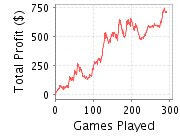Obviously, most of the tells that they speak about during the video aren't applicable to online play. But there are some good tidbits of information here. First, pay attention so you can make decisions based on what you observe. Additionally, and the part I want to cover here, profiling your opponents will also help you make good decisions. I follow four steps to profile online players:
- Determine Win/Loss Trends
- Determine Playing Styles
- Observe and Document
- Put Players on Hands
I will cover all four in detail in my Sit 'N Go Training Series. But I will briefly cover the first one, Determine Win/Loss Trends, here.
Determine Win/Loss Trends
You've all heard the saying, an object in motion tends to stay in motion. Well, the same idea goes for player win/loss trends. A player that has a winning trend will tend to continue winning and a player that has a losing trend will tend to continue losing. Winning players are doing something right at the table that makes them a winning player. Losing players are making consistent mistakes that make them losing players. So how do you determine the winning or losing trends of a player?Sharkscope.com is a subscription based tool that tracks player information for online sit 'n go tournaments. At the start of each tournament, I pull up the profiles of each player and quickly look at their graphs, ROI, and profit. By looking at the graphs I can quickly tell if they are a winning or losing player.
I use this information to categorize player. If playing at site like Full Tilt Poker, you can color code the player's avatar. Winning players I mark green, losing players I mark red. If they are identified by Sharkscope.com as a "fish", I mark them blue. Sharks I mark in purple. I can usually complete the initial profiling within about 3 to 4 hands. So how do I use this information?
I use this information to determine the amount of "respect" that I initially give a player. If a red or blue player comes in for a raise from early position, I will assume he or she has a weaker starting hand than if a purple or green player were to do the same. Likewise, if a green player calls my flop bet, I would put them on a stronger hand or draw than a red player. Now this isn't 100% fool proof. After all, even the worst players can wake up with a hand. But the key is to start to categorize your opponents and then make adjustments as you observe and learn more about their play.
Following is a table summary for a $10 sit 'n go that I picked at random. The first three players on the list I would mark as green, and the last two, the fish, I would mark as blue. I will initially give more respect to the first three players than I will the last two, because of their playing records.

By clicking on the name of each player you can pull up a graph that shows their winning/losing trend.
 For an example, see the graph on the right for depage26. This player is consistently losing at sit 'n go tournaments (and should study my lessons!). That means this player is consistently making bad decisions at the table. This is the type of player that you want to get your money in with when you have a strong hand.
For an example, see the graph on the right for depage26. This player is consistently losing at sit 'n go tournaments (and should study my lessons!). That means this player is consistently making bad decisions at the table. This is the type of player that you want to get your money in with when you have a strong hand.Notice
 karishnikov's chart looks very different... this is the chart of a winning player. Again, you want to be careful playing against this player. He is doing something right at the table. So tread carefully.
karishnikov's chart looks very different... this is the chart of a winning player. Again, you want to be careful playing against this player. He is doing something right at the table. So tread carefully.I would strongly encourage you to subscribe to the Sharkscope service (no, I am not an affiliate, but I am a subscriber!). Initially profiling players by looking at their wining/losing patterns is an important first step and well worth the low monthly cost.
No comments:
Post a Comment
Please leave me a comment and let me know what you think!